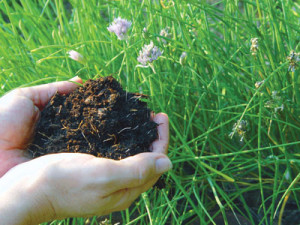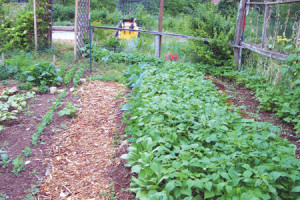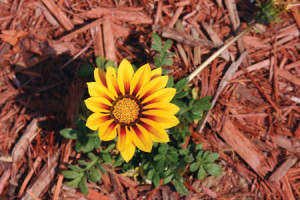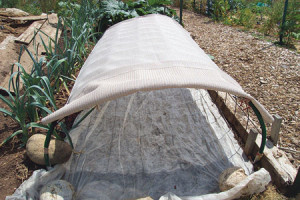More for Your Mulch
04 Mar 2009
Mulches are like sure-fire aces that protect plants and improve soil conditions.
In the game of gardening, it pays to play with mulches.
 Mulches are like aces in a poker hand. Given our region’s extreme temperatures and aridity, mulches keep plants in the game by protecting them and improving soil conditions. Mulches can be once-living organic materials like wood chips or pine needles, inorganic materials like gravel or weed-barrier fabrics, or living organic materials like cover crops such as ryegrass, buckwheat or oats.
All these materials control weeds by blocking sunlight, and help to maintain soil moisture by reducing evaporation. Mulches also moderate soil temperature by keeping the grow-zone cool in summer and warm in winter, insulating shallower roots from excessive heat and cold.
Mulches are like aces in a poker hand. Given our region’s extreme temperatures and aridity, mulches keep plants in the game by protecting them and improving soil conditions. Mulches can be once-living organic materials like wood chips or pine needles, inorganic materials like gravel or weed-barrier fabrics, or living organic materials like cover crops such as ryegrass, buckwheat or oats.
All these materials control weeds by blocking sunlight, and help to maintain soil moisture by reducing evaporation. Mulches also moderate soil temperature by keeping the grow-zone cool in summer and warm in winter, insulating shallower roots from excessive heat and cold.
 Selecting a mulch depends on your goal. For example, if appearance is important, wood chips may be an appropriate choice. But if your garden is buffeted by heavy winds, gravel would be a better option. On the other hand, if you want to improve your soil, organic mulch that gradually decays is a good alternative. If the area is used primarily for annual flowers, organic mulch that can be turned under in fall is more practical. A cover crop is a wise choice if you want to increase the soil’s beneficial microorganisms and earthworms, as well as build soil structure. But turn the crop under before it seeds or you’ll end up with more problems than it’s worth. (Larger vegetables, like squash and potatoes, can be planted in the same bed you plant the cover crops in.)
My favorite mulch—especially for acid-loving crops like potatoes—is pine needles, which I scavenge from schoolyards and parks in late fall. (The trick is to catch the groundskeeper in the act of raking.) During our windy winters, leaf, straw and wood chip mulches are blown into the next county, but pine needles stay put. When garlic shoots first emerge in early spring, I pile a thick layer of pine needles on top to keep the soil temperature constant. As May temperatures shoot up in the daytime, the needles keep the root zone cool and the garlic happy.
Selecting a mulch depends on your goal. For example, if appearance is important, wood chips may be an appropriate choice. But if your garden is buffeted by heavy winds, gravel would be a better option. On the other hand, if you want to improve your soil, organic mulch that gradually decays is a good alternative. If the area is used primarily for annual flowers, organic mulch that can be turned under in fall is more practical. A cover crop is a wise choice if you want to increase the soil’s beneficial microorganisms and earthworms, as well as build soil structure. But turn the crop under before it seeds or you’ll end up with more problems than it’s worth. (Larger vegetables, like squash and potatoes, can be planted in the same bed you plant the cover crops in.)
My favorite mulch—especially for acid-loving crops like potatoes—is pine needles, which I scavenge from schoolyards and parks in late fall. (The trick is to catch the groundskeeper in the act of raking.) During our windy winters, leaf, straw and wood chip mulches are blown into the next county, but pine needles stay put. When garlic shoots first emerge in early spring, I pile a thick layer of pine needles on top to keep the soil temperature constant. As May temperatures shoot up in the daytime, the needles keep the root zone cool and the garlic happy.
Here are a few other mulching tips:
 Never use mulch material from the crop it’s intended to protect. For example, don’t use potato vines from last year’s crop to mulch this year’s potatoes, because the old vines might transmit disease.
Use a light-colored mulch during summer and early fall to reflect heat, and a dark-colored mulch in winter and early spring to help warm the soil and permit earlier planting and hastened growth.
A mulch of older grass clippings, leaves or sawdust can cause a temporary nitrogen deficiency in the soil, as microbes tap into soil nitrogen to break down the vegetation. If you use these types of mulch, add a nitrogen source, such as well-rotted manure, before laying down the mulch.
When you consider the soil in conjunction with the plant, you begin to work with close-at-hand materials that don’t require heavy inputs of energy, like powdered fertilizers do. That’s when you realize mulches are the highest cards in the holistic gardening game.
Never use mulch material from the crop it’s intended to protect. For example, don’t use potato vines from last year’s crop to mulch this year’s potatoes, because the old vines might transmit disease.
Use a light-colored mulch during summer and early fall to reflect heat, and a dark-colored mulch in winter and early spring to help warm the soil and permit earlier planting and hastened growth.
A mulch of older grass clippings, leaves or sawdust can cause a temporary nitrogen deficiency in the soil, as microbes tap into soil nitrogen to break down the vegetation. If you use these types of mulch, add a nitrogen source, such as well-rotted manure, before laying down the mulch.
When you consider the soil in conjunction with the plant, you begin to work with close-at-hand materials that don’t require heavy inputs of energy, like powdered fertilizers do. That’s when you realize mulches are the highest cards in the holistic gardening game.













